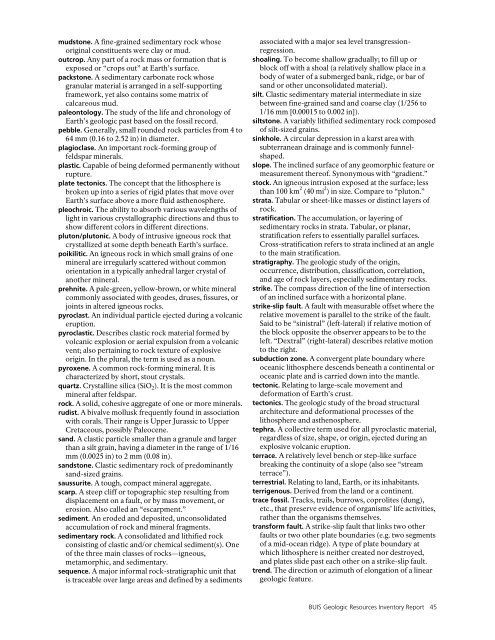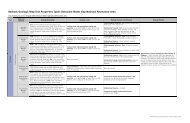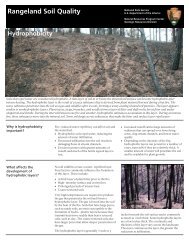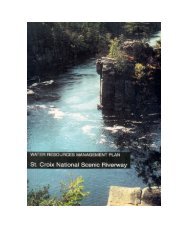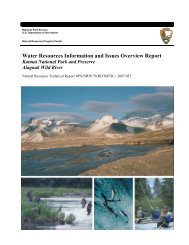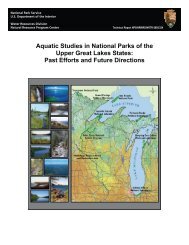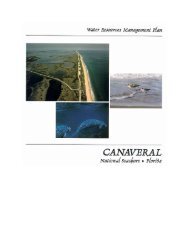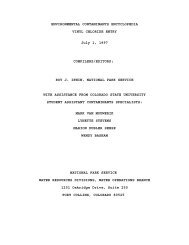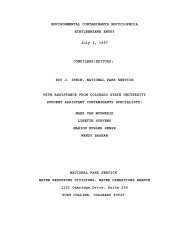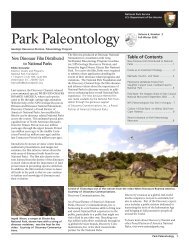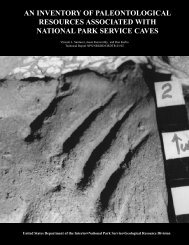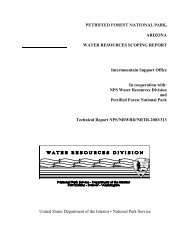Buck Island Reef National Monument Geologic Resources Inventory
Buck Island Reef National Monument Geologic Resources Inventory
Buck Island Reef National Monument Geologic Resources Inventory
You also want an ePaper? Increase the reach of your titles
YUMPU automatically turns print PDFs into web optimized ePapers that Google loves.
mudstone. A fine-grained sedimentary rock whose<br />
original constituents were clay or mud.<br />
outcrop. Any part of a rock mass or formation that is<br />
exposed or “crops out” at Earth’s surface.<br />
packstone. A sedimentary carbonate rock whose<br />
granular material is arranged in a self-supporting<br />
framework, yet also contains some matrix of<br />
calcareous mud.<br />
paleontology. The study of the life and chronology of<br />
Earth’s geologic past based on the fossil record.<br />
pebble. Generally, small rounded rock particles from 4 to<br />
64 mm (0.16 to 2.52 in) in diameter.<br />
plagioclase. An important rock-forming group of<br />
feldspar minerals.<br />
plastic. Capable of being deformed permanently without<br />
rupture.<br />
plate tectonics. The concept that the lithosphere is<br />
broken up into a series of rigid plates that move over<br />
Earth’s surface above a more fluid asthenosphere.<br />
pleochroic. The ability to absorb various wavelengths of<br />
light in various crystallographic directions and thus to<br />
show different colors in different directions.<br />
pluton/plutonic. A body of intrusive igneous rock that<br />
crystallized at some depth beneath Earth’s surface.<br />
poikilitic. An igneous rock in which small grains of one<br />
mineral are irregularly scattered without common<br />
orientation in a typically anhedral larger crystal of<br />
another mineral.<br />
prehnite. A pale-green, yellow-brown, or white mineral<br />
commonly associated with geodes, druses, fissures, or<br />
joints in altered igneous rocks.<br />
pyroclast. An individual particle ejected during a volcanic<br />
eruption.<br />
pyroclastic. Describes clastic rock material formed by<br />
volcanic explosion or aerial expulsion from a volcanic<br />
vent; also pertaining to rock texture of explosive<br />
origin. In the plural, the term is used as a noun.<br />
pyroxene. A common rock-forming mineral. It is<br />
characterized by short, stout crystals.<br />
quartz. Crystalline silica (SiO 2 ). It is the most common<br />
mineral after feldspar.<br />
rock. A solid, cohesive aggregate of one or more minerals.<br />
rudist. A bivalve mollusk frequently found in association<br />
with corals. Their range is Upper Jurassic to Upper<br />
Cretaceous, possibly Paleocene.<br />
sand. A clastic particle smaller than a granule and larger<br />
than a silt grain, having a diameter in the range of 1/16<br />
mm (0.0025 in) to 2 mm (0.08 in).<br />
sandstone. Clastic sedimentary rock of predominantly<br />
sand-sized grains.<br />
saussurite. A tough, compact mineral aggregate.<br />
scarp. A steep cliff or topographic step resulting from<br />
displacement on a fault, or by mass movement, or<br />
erosion. Also called an “escarpment.”<br />
sediment. An eroded and deposited, unconsolidated<br />
accumulation of rock and mineral fragments.<br />
sedimentary rock. A consolidated and lithified rock<br />
consisting of clastic and/or chemical sediment(s). One<br />
of the three main classes of rocks—igneous,<br />
metamorphic, and sedimentary.<br />
sequence. A major informal rock-stratigraphic unit that<br />
is traceable over large areas and defined by a sediments<br />
associated with a major sea level transgressionregression.<br />
shoaling. To become shallow gradually; to fill up or<br />
block off with a shoal (a relatively shallow place in a<br />
body of water of a submerged bank, ridge, or bar of<br />
sand or other unconsolidated material).<br />
silt. Clastic sedimentary material intermediate in size<br />
between fine-grained sand and coarse clay (1/256 to<br />
1/16 mm [0.00015 to 0.002 in]).<br />
siltstone. A variably lithified sedimentary rock composed<br />
of silt-sized grains.<br />
sinkhole. A circular depression in a karst area with<br />
subterranean drainage and is commonly funnelshaped.<br />
slope. The inclined surface of any geomorphic feature or<br />
measurement thereof. Synonymous with “gradient.”<br />
stock. An igneous intrusion exposed at the surface; less<br />
than 100 km 2 (40 mi 2 ) in size. Compare to “pluton.”<br />
strata. Tabular or sheet-like masses or distinct layers of<br />
rock.<br />
stratification. The accumulation, or layering of<br />
sedimentary rocks in strata. Tabular, or planar,<br />
stratification refers to essentially parallel surfaces.<br />
Cross-stratification refers to strata inclined at an angle<br />
to the main stratification.<br />
stratigraphy. The geologic study of the origin,<br />
occurrence, distribution, classification, correlation,<br />
and age of rock layers, especially sedimentary rocks.<br />
strike. The compass direction of the line of intersection<br />
of an inclined surface with a horizontal plane.<br />
strike-slip fault. A fault with measurable offset where the<br />
relative movement is parallel to the strike of the fault.<br />
Said to be “sinistral” (left-lateral) if relative motion of<br />
the block opposite the observer appears to be to the<br />
left. “Dextral” (right-lateral) describes relative motion<br />
to the right.<br />
subduction zone. A convergent plate boundary where<br />
oceanic lithosphere descends beneath a continental or<br />
oceanic plate and is carried down into the mantle.<br />
tectonic. Relating to large-scale movement and<br />
deformation of Earth’s crust.<br />
tectonics. The geologic study of the broad structural<br />
architecture and deformational processes of the<br />
lithosphere and asthenosphere.<br />
tephra. A collective term used for all pyroclastic material,<br />
regardless of size, shape, or origin, ejected during an<br />
explosive volcanic eruption.<br />
terrace. A relatively level bench or step-like surface<br />
breaking the continuity of a slope (also see “stream<br />
terrace”).<br />
terrestrial. Relating to land, Earth, or its inhabitants.<br />
terrigenous. Derived from the land or a continent.<br />
trace fossil. Tracks, trails, burrows, coprolites (dung),<br />
etc., that preserve evidence of organisms’ life activities,<br />
rather than the organisms themselves.<br />
transform fault. A strike-slip fault that links two other<br />
faults or two other plate boundaries (e.g. two segments<br />
of a mid-ocean ridge). A type of plate boundary at<br />
which lithosphere is neither created nor destroyed,<br />
and plates slide past each other on a strike-slip fault.<br />
trend. The direction or azimuth of elongation of a linear<br />
geologic feature.<br />
BUIS <strong>Geologic</strong> <strong>Resources</strong> <strong>Inventory</strong> Report 45


